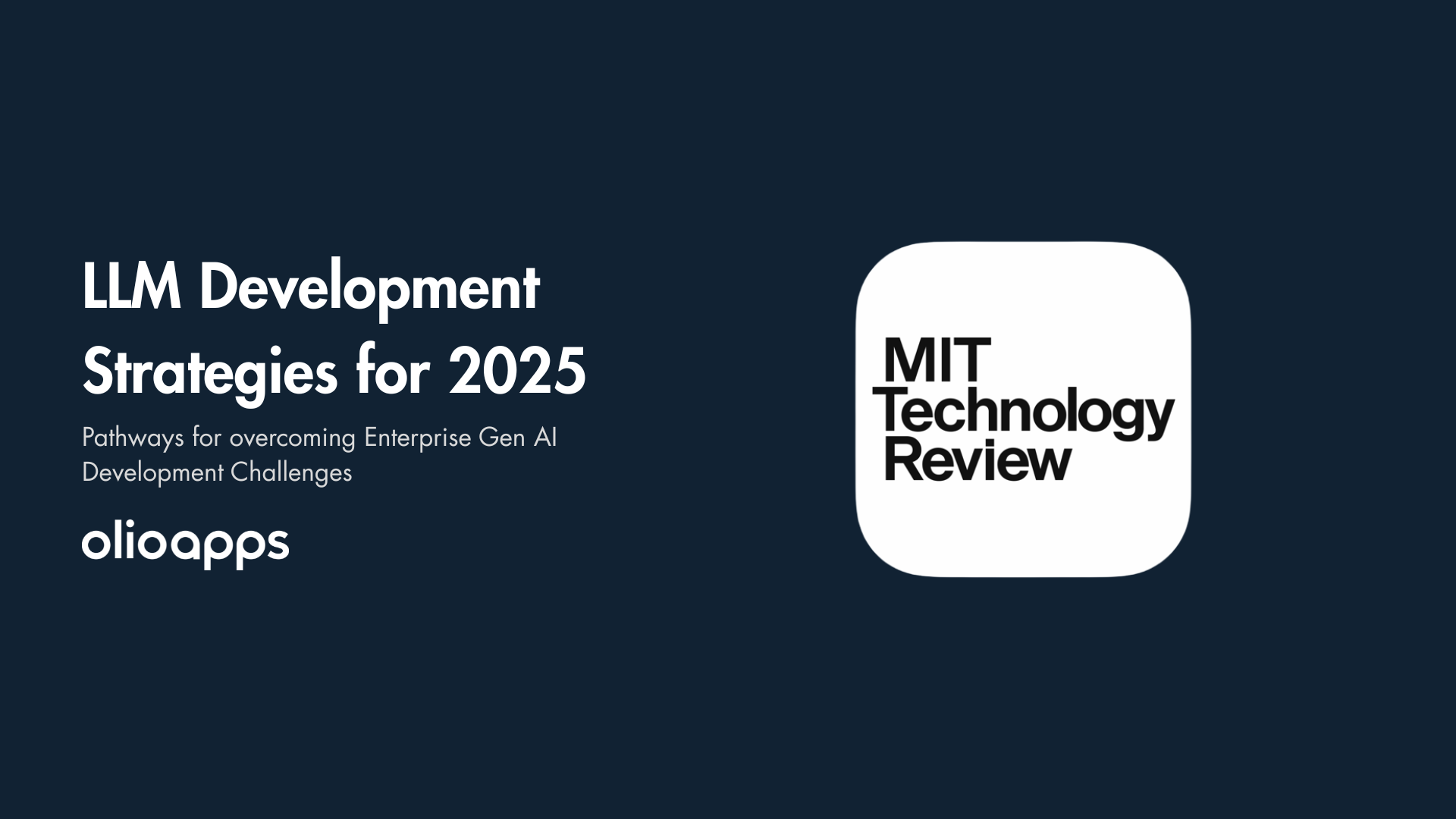

By Josh Proto
Jul 17, 2025

By Josh Proto
Jul 17, 2025
LLM Development Strategies for 2025
The journey of integrating generative AI (GenAI) into enterprise operations and business operations in general continues to evolve. A recent discussion inspired by an insightful MIT Technology Review report highlighted significant GenAI development challenges that businesses faced with Large Language Model (LLM) applications in 2024.
Drawing from these industry observations and our own development experience from developing and refining LLM solutions, this post offers a roadmap and tangible LLM development strategies for navigating the complexities of enterprise AI and overcoming common GenAI roadblocks in 2025.
Top 6 Enterprise GenAI Challenges in 2024
The MIT report identified six major obstacles hindering widespread, successful GenAI deployment in enterprises, significant roadblocks that demand clear solutions for 2025:
- LLM Hallucinations and Toxicity: A striking 72% of companies reported ongoing problems with the quality and reliability of AI-generated outputs, including factual inaccuracies (hallucinations) and inappropriate content (toxicity). Addressing this is a key strategy for building trust in LLM solutions.
- Difficult GenAI Integration with Existing Infrastructure: 62% of organizations encountered significant difficulties connecting LLMs with their organization’s broader IT infrastructure and business operations, a critical step for deploying LLMs at scale. An effective LLM development strategy must prioritize seamless integration.
- Prohibitive Costs of Fine-Tuning LLMs: Many enterprises are shifting away from resource-intensive custom model fine-tuning. Instead, they're exploring more cost-effective approaches like Retrieval-Augmented Generation (RAG) or leveraging smaller, specialized fine-tuned language models to manage the cost of fine-tuning LLMs.
- LLM Latency Issues: Slow model response times were a hurdle for 56% of companies, impacting user experience and the feasibility of real-time LLM applications. Reducing latency is vital for practical GenAI solutions.
- Scalability Problems with GenAI Applications: 51% struggled to scale their GenAI applications effectively to handle increasing user demands and larger datasets, a key factor in scaling GenAI solutions.
- Low Production Adoption of GenAI: Despite considerable buzz and bold predictions for GenAI in business, only a mere 5% of companies had achieved real production deployments by mid-2024. Overcoming this GenAI roadblock is paramount for realizing ROI.
Core Strategy - The Critical Role System Prompts Play in LLM Performance
One of the foundational lessons from our work in LLM development and a core strategy for 2025 success has been the use of system prompts. Learning how to properly implement system prompts has been essential to how we approach using LLMs. A system prompt acts like a set of guardrails for an LLM, telling it:- What role it should adopt (e.g., "You are a biomedical researcher")
- What response style it should use (e.g., "Respond in formal academic tone")
- Any rules it should follow (e.g., "Only answer based on the provided document")
Structured Output: A Key Strategy for Scaling LLM Applications Reliably
Another vital lesson for successful LLM deployment, and a crucial development strategy for 2025, is the necessity of structured output. Moving beyond simple free-form text responses is essential if you aim for your LLM applications to scale, integrate seamlessly with your existing IT infrastructure, and perform reliably. Examples of Structured Output Include- JSON (JavaScript Object Notation)
- XML (Extensible Markup Language)
- CSV (Comma Separated Values)
- It allows for easier parsing and validation. Structured responses simplify the process of programmatically parsing and validating the AI’s answers.
- It streamlines downstream automation. Structed output enables smoother automation of subsequent processes and workflows that depend on the AI output.
- It improves output quality analysis. More effective analysis and systematic improvement of the LLM's response quality is enabled over time.
- It enables a consistent user experience. Structued output ensures there is structured consistency in how information is presented to end-users of your GenAI applications.
A Critical Warning for Complex LLM Tasks
Attempting to combine complex reasoning tasks with strict structured formatting instructions within a single LLM prompt can be counterproductive. The model might overly focus on adhering to the formatting rules at the expense of reasoning accuracy, potentially leading to an increase in LLM hallucinations or nonsensical structured data. The Solution? Decouple the tasks. Allow the LLM to perform the complex reasoning first, then instruct it to structure the reasoned output in a subsequent step or with a dedicated formatting prompt. We have seen this separation leading to more reliable and accurate structured AI responses.Introducing Data Pilot: The LLM Workbench for Reliable Development
In direct response to these prevalent GenAI development challenges and to support robust LLM development strategies, we developed Data Pilot, a comprehensive LLM development platform designed to empower developers to build superior LLM prompts and measure their effectiveness across various models and use cases. Data Pilot helps your team to effectively implement GenAI best practices by: Tips to maximize productivity while minimizing tech debt:- Developing more effective prompts through a collaborative, chat-based process, centralizing prompt engineering efforts.
- Generating synthetic datasets, crucial for training and robustly testing LLMs against diverse scenarios.
- Collect, organize, and structure data to systematically evaluate LLM output quality and benchmark performance.
- Allowing you to efficiently compare the outputs of different leading LLM models (such as Claude, GPT-4, Meta Llama, and others) to select the best fit for your use case.
- First describe your goal. State your objective conversationally, like, "I need to accurately categorize incoming customer service tickets based on urgency and topic."
- Second, refine your prompt and suggest structured output. Data Pilot can assist in refining your initial prompt and automatically suggests an optimal structured output format. Test different prompts to see is the output serves your usecase.
- Third, test structured output with synthetic test case data: When prompted, the platform synthesizes realistic test cases to challenge and evaluate the LLM's categorization capabilities.
- Finally, evaluate and optimize!: Now evaluate the LLM's performance using real and synthetic data, and your refined prompt. Continue tweaking the prompt and model choices within Data Pilot to achieve desired accuracy and reliability for your use case. This workflow is the bases for informed and data-driven LLM optimization and these processes form the cornerstone of a successful LLM strategy.
Final Thoughts: 2024 Forged Hard Lessons, 2025 Demands Applied Wisdom & Strategy
The gap between the initial hype surrounding GenAI and consistent, valuable GenAI production remains, but it is steadily narrowing. The enterprises succeeding in the enterprise AI landscape today, and those poised to conquer GenAI roadblocks in 2025, are characterized by their commitment to clear LLM development strategies that include:- Investing early and consistently in disciplined prompt engineering and robust system prompt design.
- Prioritizing the generation of structured, measurable, and verifiable outputs from their LLM applications.
- Building or adopting comprehensive LLM development tools (like Data Pilot) to accelerate the development lifecycle, enhance reliability, and enable GenAI governance.
- Understanding that successful AI development is a nuanced blend of psychological insight (understanding model behavior) and rigorous engineering.
Listen to the full conversation on Code & Cognition
Listen to the full conversation on the Code & Cognition Podcast, and follow along as we continue building the future of AI-powered software.Resources Mentioned

Josh Proto
Cloud Strategist
Josh is a Cloud Strategist passionate about helping engineers and business leaders navigate how emerging technologies like AI can be skillfully used in their organizations. In his free time you'll find him rescuing pigeons with his non-profit or singing Hindustani & Nepali Classical Music.
Share This Post
Popular Articles

Using AI To Create Website Color Themes
Emma Gerigscott

Facilitating Event Driven Architecture Evolution Using Amazon EventBridge
Dustin Herboldshimer

